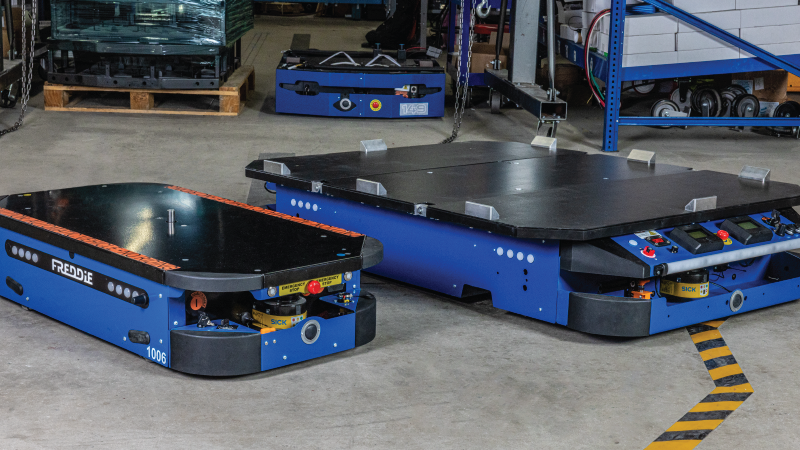Consumer demand drives change in ecommerce and retail fulfillment, pushing for distribution centers to move higher volumes and more product choices—faster.
Meanwhile, businesses from manufacturers to warehouse operators, especially among small-to-medium-sized businesses, struggle to meet those demands. Labor shortages, employee churn, and even available space within DCs are creating real growth constraints.
It’s time to bring in the robots.
For many people, the word “robot” conjures up old-school images of imposing, clunky, monster machines. Let’s be clear: That’s not what we’re talking about in this month’s Huddle with Fetch Robotics, recently acquired by our partner, Zebra Technologies.
Fetch is making it simpler, faster, and easier to implement autonomous mobile robots (AMRs) to reduce strain on warehouse pickers, improve employee experience, free up space, and contribute to manufacturing and warehouse process improvements.
In this Huddle, we take a closer look at the ways AMRs are delivering on-demand automation and making the benefits of robotics almost instantly accessible to virtually any business, at just about any scale. This month’s conversation includes:
- Jody Costa, Vice President of Marketing and Strategic Partnerships, Barcoding, Inc.
- Rick Driscoll, Channel Manager, Fetch Robotics North America
- Des Smith, Senior Engineer, IoT Automation, Barcoding, Inc.
In this article, we share some of the top takeaways, but this information-rich discussion is one you won’t want to miss…so be sure to check out the video!
Zebra Technologies is a global company whose products are providing innovative solutions in over 100 countries worldwide. Zebra’s the leading brand in barcode printers, scanners, RFID technology, handheld computers, and many more technologies and solutions that support efficiency and productivity all along the supply chain.
Fetch Robotics is the pioneer of on-demand automation. Fetch’s AMRs optimize each-picking in fulfillment centers, case picking in distribution centers, just-in-time material delivering in manufacturing facilities, and automating material movement just about anywhere.
Solving for Multiple Challenges
Autonomous robots represent one of the most exciting ways operations leaders are mitigating the strain on their resources while supporting increased efficiency and productivity. It’s not a simple problem, either. Employers don’t just struggle to find willing workers; in some cases, DC operators are experiencing annual employee turnover that exceeds 100%.
One workplace-transforming factor robots introduce to a facility is their unlimited capacity for tedium. Warehouse workers can spend half—or even more—of a workday simply walking, often pushing a cart, moving items from one location to another. In an environment where demand for humans is tight, it makes good sense to delegate the non-value-added tasks to non-humans when possible. Case in point: how many workers and how much time are committed to moving dunnage and other waste? It’s a perfect job left to the robots.
Eliminating the most time-consuming and tedious duties doesn’t just leave more time for valuable work; it also helps make each workday more productive and fulfilling for the worker. But AMRs are doing more than that. Because they’re simple and quick to deploy, they don’t add to IT teams’ workloads. Their safety features help protect workers’ well-being and support an accident-free production floor.
Robots’ cool factor shouldn’t be discounted, either. Bringing an element of fun to the job can move the needle on recruiting and retention, too.
AMRs: a Logical Next Step in Warehouse Automation
Automation has played an increasing role in driving efficiency and productivity improvements in manufacturing, warehousing and distribution, and logistics. AMRs introduce new levels of flexibility, agility, affordability, and speed-to-ROI that conveyor belts and autonomous guided vehicles (AGVs) haven’t yet been able to offer.
Unlike the single path an AGV or conveyor follows, an AMR autonomously maps a facility and allows the user to select essentially as many stopping points as they need. And in terms of space constraints, AMRs are less demanding, since they’re dynamic and able to be redeployed. Conveyors need their own space, and AGVs require significantly more dedicated area, plus an installed guidance system (laser, magnetic, or otherwise). That requires construction—which in turn requires downtime and big-ticket investment.
AMRs, on the other hand, can be implemented and up and running in as little as three days, with little to no additional IT investment needed to support them. An AMR is programmed to know where it is and where it needs to go, and its automation enables it to determine the best way to get there using configurable parameters. And AMRs are designed to work effectively around people, equipped with LiDAR sensors and 3D cameras. If a path is blocked, the AMR, unlike an AGV, can simply navigate around the person or obstacle.
And even AGVs and conveyors can face volume limits, constraining just how much help they can be—whereas a fleet of AMRs can be scaled up or down fast.
How fast?
Fetch AMRs can be deployed in as little as three days (yes, really!). Here’s how it works:
- Day 1: AMRs are delivered, connected to the wi-fi, and granted access through firewall portals
- Day 2: AMRs autonomously map the facility
- Day 3: User designates and names locations
That’s it. Locations can be updated or changed. AMRs can be added as needed to scale up, or easily removed to scale down.
And now, companies can acquire Zebra’s AMRs using a one-time purchase order—or in 36 monthly payments. Adding autonomous robotics can be as simple as a cellphone plan.
Simplified Integration Thanks to Zebra
Zebra Technologies’ leadership in the supply chain space comes in clutch to streamline technology integrations. FetchCoreTM cloud-based software seamlessly integrates with warehouse management software solutions, and mobile devices can be integrated to signal AMRs to request and schedule movements. The software’s drag-and-drop menu and graphical interface minimize the need for specialized IT involvement, and simple if-then workflows eliminate the need to know how to program to set up and modify the map.
But an AMR doesn’t have to be fully integrated right away. In fact, plenty of operations put them straight to use and make WMS integration a second phase. And by fitting an AMR with equipment like RFID sensors, it can even do the work of locating tagged items or cycle counting.
That’s part of what makes it fast and easy to achieve ROI. Most users can expect their investment to pay off in a year to two. (Watch the video to learn about a user who saw ROI in just months!)
What About the Warehouse Workers?
It’s hard to understate this: the workplace still needs people. AMRs don’t eliminate the need for human workers; on the contrary, they take the most tedious, least interesting tasks off people’s hands to make a day’s work at the warehouse, manufacturing facility, or DC safer, more interesting, more productive—and even more fun. For more supply chain insights and ideas, read our research report.







